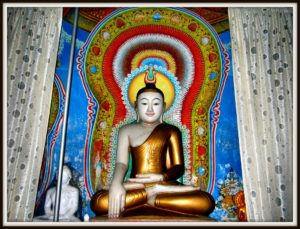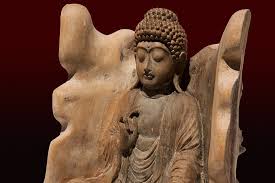The argument has been put forward by some that Buddhism is more of a philosophy than a religion. There is a lot of overlap, as both the definitions of religion and philosophy involve systematic bodies of knowledge.
 However, religion tends to concentrate on the superhuman or supernatural. The founder of Buddhism, Siddhartha Gautama, concentrated on the practical application of his ideas in this life rather than concentrate upon a particular god or set of gods. In fact, the concept of “god” in Buddhism is typically an impersonal force rather than a being. Because Gautama concentrated upon the suffering that people experience in this existence, perhaps it is more philosophical than most religions.
However, religion tends to concentrate on the superhuman or supernatural. The founder of Buddhism, Siddhartha Gautama, concentrated on the practical application of his ideas in this life rather than concentrate upon a particular god or set of gods. In fact, the concept of “god” in Buddhism is typically an impersonal force rather than a being. Because Gautama concentrated upon the suffering that people experience in this existence, perhaps it is more philosophical than most religions.
One reason that the notion of god is side-stepped is that Gautama believed it was of no consequence. His philosophical teachings concentrated upon how to break the cycle of suffering in this existence. Awakening and liberation were emphasized. He deemed it as a distraction and discouraged his followers from arguing over fruitless ideas. It wasn’t until long after his death that others began to add certain philosophies to the different schools of thought.
Some might object to considering Buddhism a philosophy
The article “Buddha” at the Stanford Encyclopedia of Philosophy covers several reasons why which are outside the scope of this article. Still, any organized religion is going to have a guiding philosophy based upon its beliefs. However, philosophy is not required to have any beliefs in the supernatural, so while there is overlap, they are not the same.
It is important to remember that Buddhism, like other major religions, has sects that disagree upon certain details. However, also like other major religions, there are central truths that are in common to all sects. The commonality is found in the oldest Buddhist scriptures, upon which Buddhist philosophy and all other doctrines of the given sects are based.
Ancient India and Buddhism
Buddhism was founded in the midst of ancient India, and it seems there were numerous ascetics during the time period of its founders who were becoming increasingly dissatisfied with much of the Hindu religions. They rejected the Vedas, the Hindu scriptures. Some went as far as to declare the entire system of the Brahmins as corrupt.
Gautama’s spiritual journey starting by seeking an answer to why there is suffering in the world. By strict meditation, he entered “enlightenment,” which is that state in which one is spiritually “awakened,” or able to see through this existence, and understands that this life and its sense of individual self are all an illusion. By accepting this and controlling the attitudes which cause suffering, he believed one could end the cycle of birth, death, and rebirth.
Basics of Buddhism
According to the PBS article, “Basics of Buddhism,” “More simply put, suffering exists; it has a cause; it has an end, and it has a cause to bring about its end. The notion of suffering is not intended to convey a negative world view, but rather, a pragmatic perspective that deals with the world as it is, and attempts to rectify it.”
Furthermore, he believed that karma played a significant role in a person’s life. Bad actions resulted in unhappiness, while good actions resulted in a lack of suffering or even happiness. Karma may extend beyond one’s current lifetime but more often affected the present one.
 From this foundation, Buddha Gautama formulated the Four Noble Truths:
From this foundation, Buddha Gautama formulated the Four Noble Truths:
1. There is suffering (dukkha).
2. There is a cause of suffering, and it is an attachment.
3. There is an end to suffering, and it is accomplished by overcoming attachment.
4. There is a path to the cessation of suffering.
Suffering may be physical, mental or emotional in nature. Frustration is a type of suffering. Attachment is the key that causes suffering in this world, according to Buddha.
The problem is that this world is transitory, and so attachments to anything in this world are impermanent (annica). The passing away of the people and things people are attached to causes suffering.
Not only is this world only temporary, but much of it is an illusion. The largest illusion is the “illusion of self” (anatta). This sense of self leads one to attach to things in a sense of ownership. However, the reality is not this illusory self, but the reality is that everyone is part of a greater consciousness. Holding oneself to the permanence of this existence or of the individual self prevents one from being liberated from suffering.
Therefore, the three characteristics of this existence are suffering, impermanence and the illusion of self. Ignorance of these realities is what leads to more suffering. It will lead to desire and aversion, which will lead to more attachments in ignorance, and so on. Dispelling this ignorance allows the individual to break the cycle at the cause. Putting away desire and aversion lessens attachments. Lessening attachments lead to less suffering.
It is important to understand there are degrees of desire and degrees of aversion. According to “The Basics of Buddhist Wisdom” by Dr C. George Boeree at Shippensburg University, aversion may refer to any in the spectrum of simple avoidance to outright hatred.
However, it takes discipline, training, and practice. A person must be trained to engage in behavior and thought in order to replace behaviors that lead to attachments. Engaging in this training is to take part in the dharma, the path or the “Middle Way.” It has eight parts, so it is known as the Noble Eightfold Path.
In summary, the Eightfold Path, in its three divisions, is:
Prajna or Panna
1. Right view – true understanding of the Four Noble Truths.
2. Right aspiration – the desire to be free from attachments.
3. Right speech – avoiding lies and harmful speech.
Sila
4. Right action – avoiding hurtful behavior.
5. Right livelihood – making a living in an honorable way.
6. Right effort or diligence – nurture good qualities and banish negative qualities.
Samadhi
7. Right mindfulness or attention – focusing on body, mind, feelings and mental qualities with the intent of putting away greed and distress.
8. Right concentration or meditation – using a meditative state to reach self-awareness and self-awakening.
This Middle Way avoids extremes, especially in the area of metaphysical views. It engages neither in mortifying nor indulging the self. It puts away the illusions and delusions associated with a temporary existence.
Different schools put different emphasis upon different texts; different ideas of ethics and have evolved different philosophies beyond these as a result. The two major branches of Buddhism are Theravada and Mahayana.
Theravada Buddhism is the oldest. It is fairly conservative in approach. It tends to be favored in Southeast Asian countries. They concentrate on experience and logical thinking.
Mahayana spread from India, and it is favored in India, China, Japan, Korea, and others. It is the largest faction. It is also the most diverse. Mahayana tends to go beyond the seeking of Nirvana, which they view as too narrow. Rather, they seek perfection and omniscience as quickly as possible. They are the most likely to engage in philosophical debate.
As disparate as these groups are, however, they all acknowledge the core beliefs, according to “Theravad – Mahayna Buddhism” on Buddhanet: Dukkha, annica, anatta, the Four Noble Truths, the Noble Eightfold Path and its three divisions (panna, sila, smadhi), and the twelve-fold chain of dependence from ignorance to rebirth. In addition, both reject the notion of a supreme creator that governs this world.





